Author: imToken
Stock tokenization is becoming the best narrative for the integration of TradFi and Web3 by 2025.
Data from rwa.xyz shows that the scale of tokenized stock assets has surged from nearly zero to hundreds of millions of dollars this year, indicating that stock tokenization is accelerating from concept to reality—evolving from synthetic assets to real stock custody, and extending towards more advanced forms like derivatives.
This article will briefly outline the evolution of stock tokenization models, review core projects, and look ahead to potential development trends and changes in the landscape.
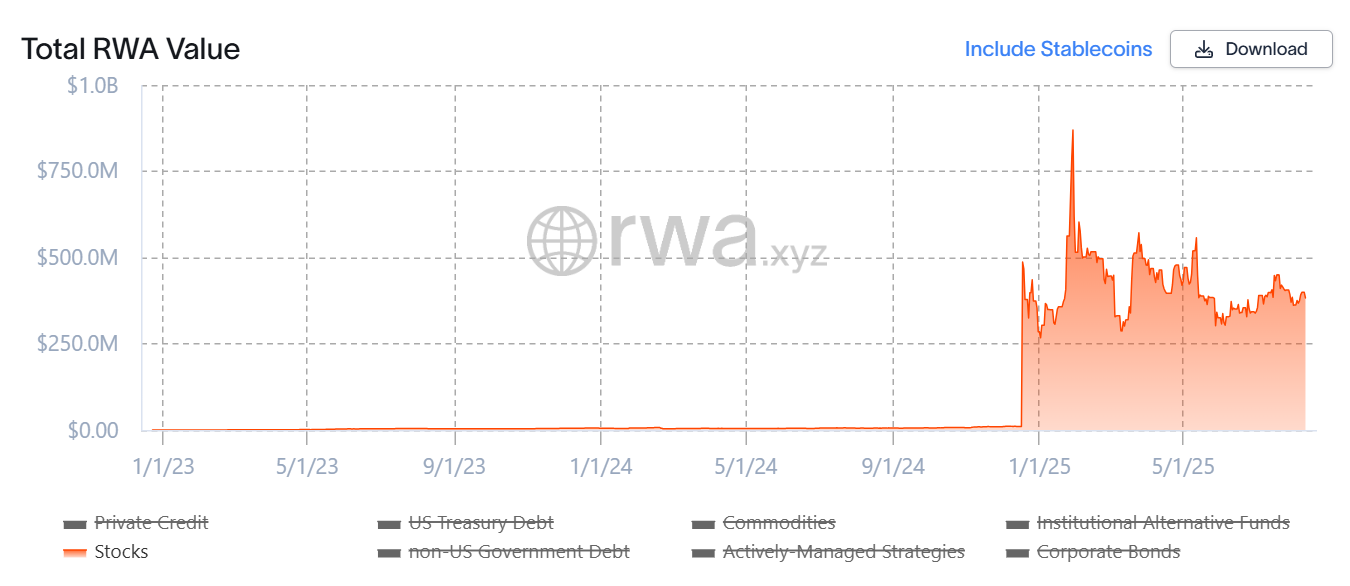
Source: rwa.xyz
1. The Past and Present of US Stock Tokenization
What is stock tokenization?
In simple terms, it is the process of mapping traditional stocks into digital tokens using blockchain technology, where each token represents a portion of ownership of the underlying asset. These tokens can be traded on-chain 24/7, breaking the time and geographical limitations of traditional stock markets, allowing global investors to participate seamlessly.
From the perspective of tokenization, US stock tokenization is not a new concept (see further reading: “The Surge of US Stock Tokenization: A New Compliance Restart of Old Narratives and Financial Infrastructure Reconstruction”). After all, in the previous cycle, representative projects like Synthetix and Mirror had already explored a complete set of on-chain synthetic asset mechanisms:
This model not only allows users to mint and trade US stock tokens like TSLA and AAPL through over-collateralization (such as SNX and UST), but it can also cover fiat currencies, indices, gold, and crude oil, encompassing almost all tradable assets. The reason is that the synthetic asset model tracks the underlying assets and uses over-collateralization to mint synthetic asset tokens.
For example, users can stake $500 worth of crypto assets (like SNX or UST) to mint synthetic assets (like mTSLA or sAAPL) pegged to the asset price and trade them. The entire operation mechanism uses oracle pricing + on-chain contract matching, with no real trading counterparties, theoretically allowing for infinite depth and a no-slippage liquidity experience.
However, this model does not genuinely own the corresponding stocks; it merely "bets" on the price, which means that once the oracle fails or the collateral assets collapse (as Mirror did during the UST crash), the entire system faces risks of liquidation imbalance, price decoupling, and loss of user confidence.
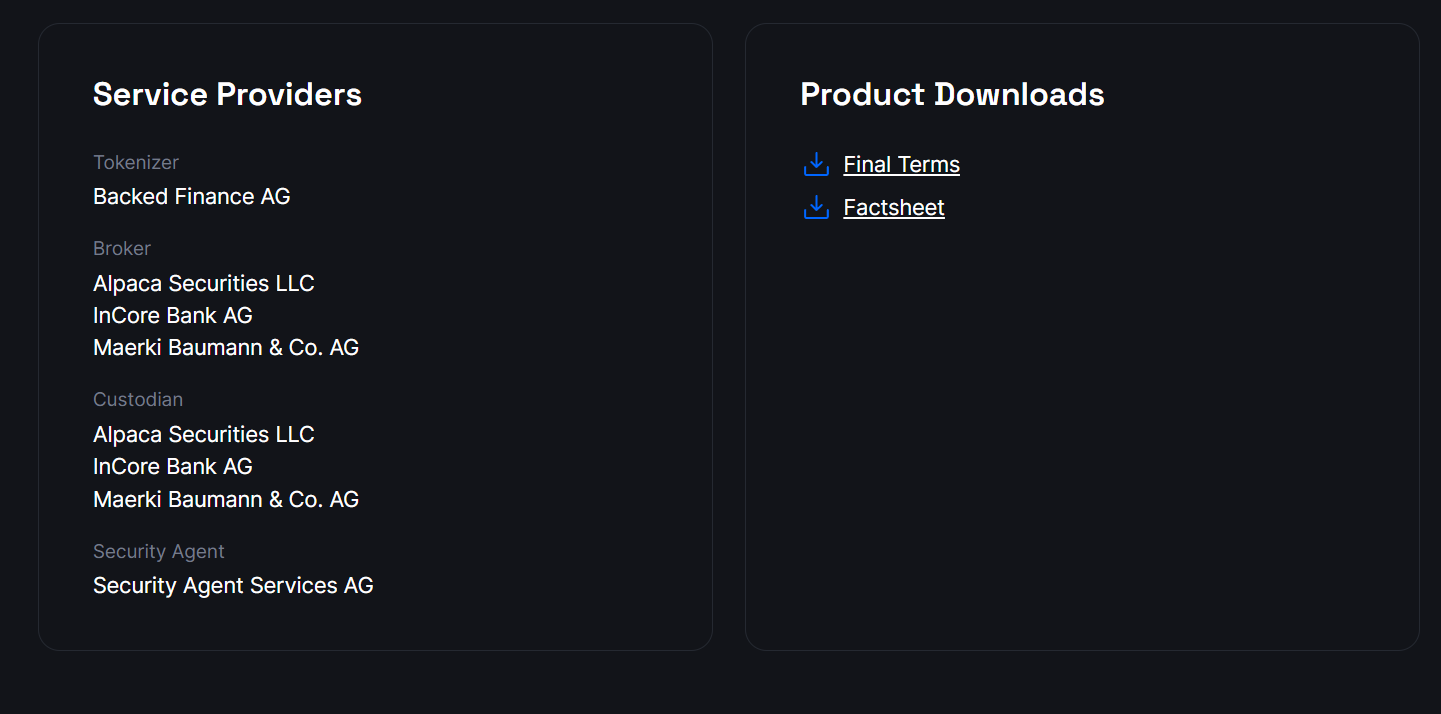
Source: Mirror
The biggest difference in this wave of "US stock tokenization" is the adoption of a "real stock custody + mapped issuance" underlying model. This model currently mainly divides into two paths, with the core difference being whether they have compliance qualifications for issuance:
- One type is represented by Backed Finance (xStocks) and MyStonks, which follows a "third-party compliant issuance + multi-platform access" model, where MyStonks collaborates with Fidelity to achieve a 1:1 peg to real stocks, and xStocks purchases stocks through Alpaca Securities LLC for custody;
- The other type is a Robinhood-style licensed brokerage self-operated closed loop, relying on its brokerage license to complete the entire process from stock purchase to on-chain token issuance;
From this perspective, the key advantage of this round of stock tokenization is that the underlying assets are genuinely verifiable, with higher security and compliance, making it easier for traditional financial institutions to recognize.
2. Review of Representative Projects: The Upstream and Downstream Ecosystem from Issuance to Trading
From an operational architecture perspective, a fully functional tokenized stock ecosystem actually needs to include infrastructure layers (public chains, oracles, and settlement systems), issuance layers (various issuers), and trading layers (CEX/DEX, lending, and other derivative trading platforms). Without any one layer, the ecosystem would struggle to achieve secure issuance, effective pricing, and efficient trading.
Around this framework, we can see that the main market participants are laying out their strategies around different links. Considering that the infrastructure (such as public chains, oracles, and settlement networks) is relatively mature, the issuance and trading links are the main battleground for competition in tokenized stocks. Therefore, this article will focus on reviewing these representative projects that directly impact user experience and market liquidity.
Ondo Finance: The Stockization Extension of RWA Leader
First is Ondo Finance, as the leading project in the RWA tokenization track, initially positioned as a tokenization platform for on-chain bonds and government bonds. As of the time of writing, Ondo Finance, relying on its two flagship products USDY and OUSG based on US Treasury bonds, still firmly occupies a core position in the top ten of the RWA tokenization track.
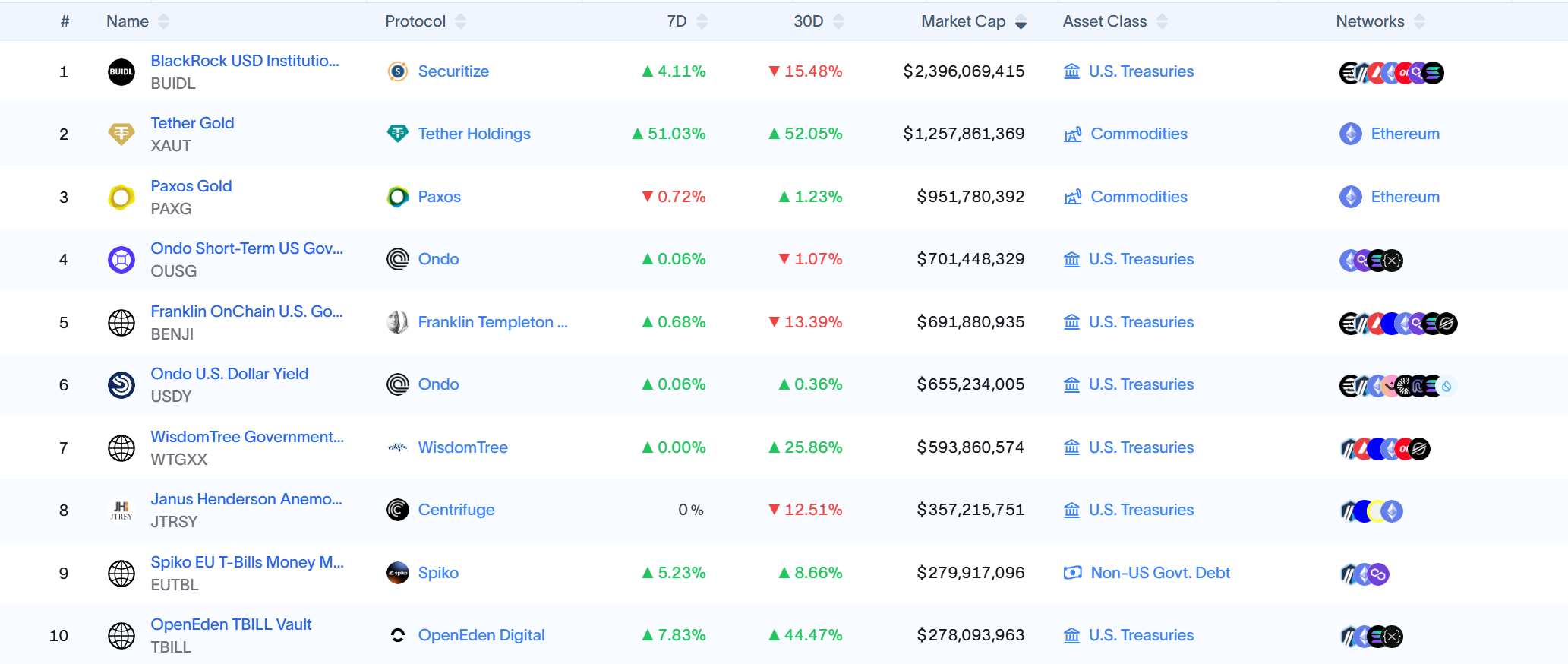
Source: rwa.xyz
However, since last year, Ondo Finance has been attempting to expand its territory into the stock market, including collaborating with regulated custodians and clearing institutions like Anchorage Digital to securely custody real US stocks and issue equivalent tokenized assets on-chain. This model not only provides compliance guarantees for institutional investors but also builds cross-asset liquidity pools on-chain, allowing tokenized stocks to be traded in combination with stablecoins, RWA bonds, and other assets.
Moreover, last month, Ondo Finance also partnered with Pantera Capital to launch a $250 million fund to support RWA projects. Ondo's Chief Strategy Officer Ian De Bode stated that these funds will be used to acquire equity and tokens of emerging projects.
Injective: A Public Chain Tailored for Financial RWA
Injective has always been positioned as "financial infrastructure" and is one of the public chains focused on high-performance financial applications. Its self-developed on-chain matching and derivatives trading modules provide targeted optimizations in terms of latency, throughput, and order book depth.
As of now, the Injective ecosystem has aggregated over 200 projects, covering decentralized exchanges (Helix, DojoSwap), on-chain lending (Neptune), RWA platforms (Ondo, Mountain Protocol), NFT markets (Talis, Dagora), and more.
In the RWA track, Injective's advantages mainly lie in two aspects:
- Wide asset class coverage: Projects in the Injective ecosystem, represented by Helix, have supported trading of various tokenized assets, including US tech stocks, gold, and foreign exchange, expanding the asset spectrum of RWA on-chain;
- Direct connectivity with traditional finance: Injective has established partnerships with well-known financial institutions such as Coinbase, Circle, Fireblocks, WisdomTree, and Galaxy, creating a closed-loop process from off-chain custody and clearing to on-chain mapping and trading;
Thanks to this positioning, Injective serves as a dedicated public chain base for RWA, providing issuers with stable compliance landing and asset management channels, offering trading platforms and aggregation tools a high-speed, low-cost execution environment, and laying the foundation for the future derivative and composite nature of stock tokenization.
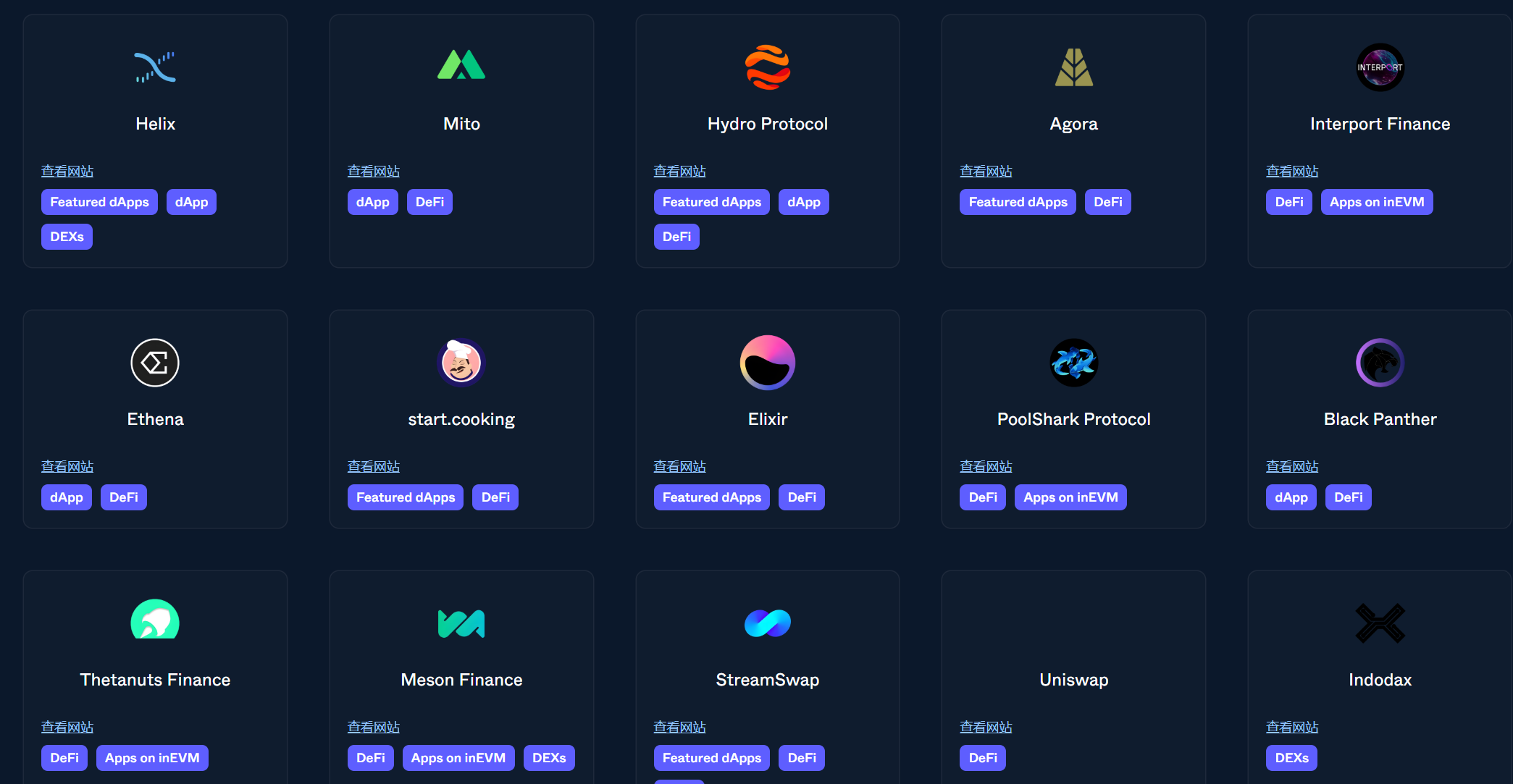
Source: Injective
MyStonks: A Pioneer of On-Chain US Stock Liquidity
As a pioneer in the field of US stock tokenization, many users should have encountered the tokenized US stocks issued by MyStonks on-chain, which also collaborates with Fidelity to ensure that on-chain token assets are fully pegged to real stocks.
In terms of trading experience, MyStonks adopts a payment for order flow (PFOF) mechanism, routing order flow to professional market makers for matching, significantly reducing slippage and trading costs, and enhancing order execution speed and depth. For ordinary users, this means that when trading US stocks on-chain, they can enjoy liquidity close to that of traditional brokerages while retaining the advantage of 24/7 trading.
It is worth mentioning that MyStonks has not limited itself to on-chain spot trading but is actively expanding into diversified financial services such as derivatives, lending, and staking. In the future, users will not only be able to conduct leveraged trading of US stock tokens but also use their holdings as collateral to obtain stablecoin liquidity, and even participate in composite investment and yield optimization strategies.
Backed Finance: A Compliant Expander Across Markets
Unlike MyStonks, which focuses on US stocks, Backed Finance's layout has always had a more cross-market and multi-asset vision, with a major highlight being its compliance model and high alignment with the European MiCA regulatory route.
The team operates based on the Swiss legal framework, strictly adhering to local financial regulatory requirements, issuing fully pegged tokenized securities on-chain, and establishing a stock purchase and custody system in collaboration with partners like Alpaca Securities LLC to ensure a 1:1 mapping relationship between on-chain tokens and off-chain assets.
In terms of asset scope, Backed Finance not only supports US stock tokenization but also covers ETFs, European securities, and specific international index products, providing global investors with multi-market, multi-currency, and multi-target investment options. This means that investors can simultaneously allocate US tech stocks, European blue-chip stocks, and global commodity ETFs on the same on-chain platform, breaking the geographical and temporal limitations of traditional markets.
Block Street: A Liquidity Releaser for Tokenized Stocks
Block Street, as one of the few DeFi protocols currently focused on lending tokenized stocks, is targeting a downstream direction that is more explosive in potential liquidity release.
This is also a niche segment where the "trading layer" of tokenized stocks is still blank. Taking Block Street as an example, it directly offers on-chain collateral and lending services to holders—users can deposit tokenized US stocks like TSLA.M and CRCL.M directly into the platform as collateral, obtaining stablecoins or other on-chain liquid assets based on the collateral ratio, achieving a funding utilization model of "not selling assets, but obtaining liquidity."
Block Street just launched its test version last week, allowing users to experience converting tokenized stocks into liquid capital, enabling holders to release funds without selling their assets. This also fills the gap in the DeFi lending space for tokenized stocks, making it worth observing whether similar lending, futures, and other derivative directions will construct a "second curve" for the tokenized stock market.
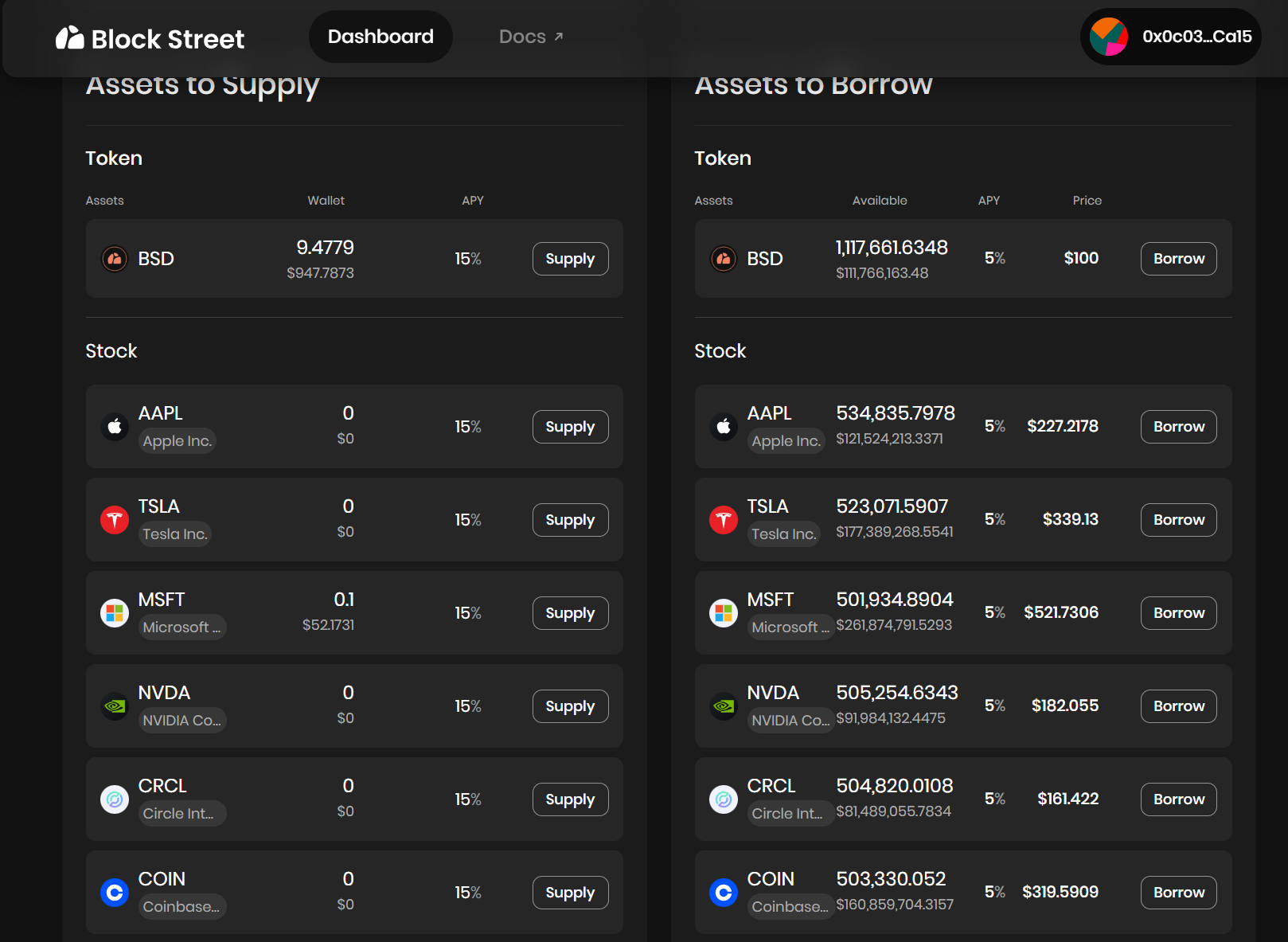
Source: Block Street
3. How to Further Tear Down the Walls?
Objectively speaking, the biggest advancement in the current wave of US stock tokenization is the "real stock custody" model + the reduction of entry barriers:
Any user only needs to download a crypto wallet and hold stablecoins to bypass account opening thresholds and identity checks through DEXs, allowing them to directly purchase US stock assets anytime and anywhere—no US stock account, no time zone issues, and no geographical or identity restrictions.
However, the problem is that most products currently focus on the first step of issuance and trading layers, essentially remaining at the initial stage of digital certificates, and have not truly transformed into on-chain financial assets that can be widely used for trading, hedging, and capital management. This indicates a significant shortfall in attracting professional traders, high-frequency funds, and institutional participation.
This is somewhat akin to ETH before DeFi Summer, when it could not be lent, used as collateral, or participate in DeFi, until protocols like Aave endowed it with functions like "collateralized lending," releasing hundreds of billions in liquidity. For US stock tokens to break through their predicament, they must replicate this logic, allowing the accumulated tokens to become "collateralizable, tradable, and combinable living assets."
Therefore, if the first curve of the tokenized US stock market is the growth of trading volume, then the next second curve will be the expansion of financial tools to improve the capital utilization and on-chain activity of tokenized stocks. Such product forms are likely to attract a broader flow of on-chain capital, forming a complete capital market cycle.
In this logic, beyond the instant buying and selling of tokenized stocks, a richer array of derivative trading in the "trading layer" is particularly crucial—whether it is DeFi lending protocols like Block Street or future shorting tools, options, and structured products that support reverse positions and risk hedging.
The core lies in who can first create products with strong combinability and good liquidity, and who can provide an integrated on-chain experience of "spot + shorting + leverage + hedging." For example, allowing tokenized US stocks to serve as collateral for capital borrowing in Block Street, constructing new hedging targets in options protocols, and forming combinable asset baskets in stablecoin protocols.
Overall, the significance of stock tokenization lies not only in bringing US stocks and ETFs on-chain but also in opening up the "last mile" between real-world capital markets and blockchain:
From the issuance layer of Ondo, to the trading and cross-market access of MyStonks and Backed Finance, and finally to the liquidity release of Block Street, this track is gradually building its underlying infrastructure and ecological closed loop.
The main battlefield for RWA was previously dominated by US Treasuries and stablecoins. As institutional funds accelerate their entry and on-chain trading infrastructure continues to improve, tokenized US stocks are becoming combinable, tradable, and collateralizable living assets. Stock tokenization is undoubtedly poised to become the most scalable and incremental asset class in the RWA track.
免责声明:本文章仅代表作者个人观点,不代表本平台的立场和观点。本文章仅供信息分享,不构成对任何人的任何投资建议。用户与作者之间的任何争议,与本平台无关。如网页中刊载的文章或图片涉及侵权,请提供相关的权利证明和身份证明发送邮件到support@aicoin.com,本平台相关工作人员将会进行核查。




